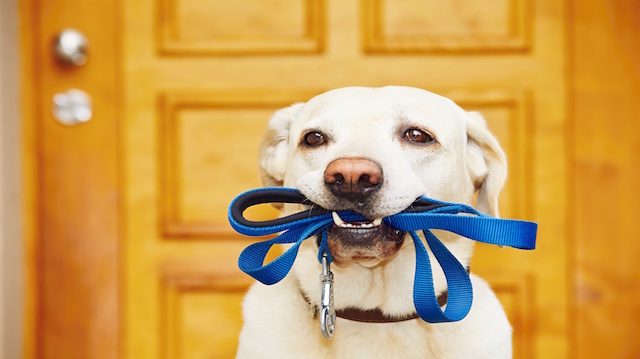
Your veterinarian may prescribe anti-anxiety medications for your dog, often the same drugs used in humans but in smaller doses. These may help but at the risk of serious side effects. There are other, more natural ways to relieve your pet’s anxiety before resorting to powerful pharmaceuticals.
Herbal help
Herbs with calming properties can help your anxious dog. Some of the best known include:
- Chamomile — This effective herb is safe to use long-term.
- Valerian — While calming, this herb also has sedative properties.
- St. John’s wort — Used for dogs with separation anxiety, this herb also acts as an antidepressant.
Herbal remedies are available in capsule and tincture forms and can be mixed in the food or water. One caveat: Many herbal canine remedies should not be used for extended periods. Consult a holistic veterinarian about the best herbs or combination of herbs for your dog, along with dosing information.
Essential oils
Essential oils can reduce canine anxiety when used in a number of ways. However, it’s imperative that you use only therapeutic-grade pure oils, as lower-grade oils often contain impure additives.
Lavender is the most useful essential oil for canine calming. You can use it in a diffuser, and/or simply place the vial under the dog’s nose so he inhales a relaxing whiff. Place just a few drops behind his ears or on his stomach and gently rub it in. Other calming essential oils include:
- Bergamot
- Clary
- Sweet orange
- Ylang ylang
Essential oils are powerful, and it’s crucial to seek advice from a holistic veterinarian or holistic oil practitioner when using them on your pet. If you have birds or small pets such as hamsters or guinea pigs in the house, don’t use an essential oil diffuser in their vicinity. Cats are also sensitive to many essential oils, so avoid using diffusers or aromatherapy if you share your home with felines, too.
Exercise
The old saying, “A tired dog is a good dog,” certainly rings true. Many modern dogs do not get enough exercise, and all that pent-up energy needs an outlet. For some canines, the outlet is destructive behavior, while for others it’s constant anxiety, or a combination of the two. Take your best friend out for frequent walks, runs and games of fetch. You might involve him in canine activities such as agility or flyball. Not only will extra exercise help calm your dog down, it’s a great way to strengthen the bond between you and him.
Mood music
If your dog experiences separation anxiety, try leaving the radio on a classical music station when you’re out of the house. You can also play gentle “new age” tunes designed to create a peaceful atmosphere. If there’s a TV in the room where your dog stays in your absence, leave it on — but turn off the sound — to provide visual stimulation and distraction.
Anxiety vests
 If your dog suffers from noise phobia and freaks out at the first roll of thunder, an anxiety vest helps keep him calm. It may literally save his life on the Fourth of July when panicked dogs may jump through doors and windows to “escape” the sounds of fireworks. These vests, found under various brand names, work on a simple principle: They apply pressure to the dog’s torso, and this pressure aids in anxiety relief. It’s similar to the ancient practice of swaddling infants.
If your dog suffers from noise phobia and freaks out at the first roll of thunder, an anxiety vest helps keep him calm. It may literally save his life on the Fourth of July when panicked dogs may jump through doors and windows to “escape” the sounds of fireworks. These vests, found under various brand names, work on a simple principle: They apply pressure to the dog’s torso, and this pressure aids in anxiety relief. It’s similar to the ancient practice of swaddling infants.
Famed animal behaviorist and autism activist Dr. Temple Grandin and colleagues presented their research on canine pressure wrapping in a paper entitled “The Effect of a Pressure Wrap (ThunderShirt) on Heart Rate and Behavior in Canines Diagnosed with Anxiety Disorder,” which appeared in the September/October 2014 issue of the Journal of Veterinary Behavior. Their study involved 90 adult dogs diagnosed with either separation anxiety or general anxiety disorder. The dogs were separated into three groups:
- Group 1 – Wore the anxiety vest as per the manufacturer’s recommendations
- Group 2 – Wore the anxiety vest fitted loosely, not snugly as per the manufacturer
- Group 3 – Did not wear a vest
Researchers measured each animal’s heart rate at baseline and after the dog spent 15 minutes by itself in a kennel. Videos were recorded of each dog during the entire testing process. Results showed that dogs in Group 1 — correctly wearing the anxiety vest — “showed significantly less increase from baseline in average heart rate” than dogs in the other groups. Videos showed less stress reduction behaviors, such as tongue-flicking, in Group 1 dogs than those in the other groups.
Before turning to pharmaceutical medications, try some of these natural anxiety-reducing options for a healthier —and happier — best friend.
—Jane Meggitt
Jane Meggitt graduated from New York University and worked as a staff writer for a major New Jersey newspaper chain. Her work on pets, equines and health have appeared in dozens of publications, including The Daily Puppy, The Nest Pets, Horse News, Hoof Beats and Horseback magazines.
Sources:
http://www.mnn.com/family/pets/stories/7-natural-remedies-for-anxious-dogs
http://www.thundershirt.com/faq
http://www.thundershirt.com/media/docs/Dr.%20Grandin%20Research%20on%20Calming%20Effect%20of%20ThunderShirt.pdf
http://www.dogsnaturallymagazine.com/natural-help-dog-separation-anxiety/
https://www.vetinfo.com/herbal-remedies-for-anxiety-in-dogs.html
http://thebark.com/content/essential-oils-and-dogs

